Task Templates – Reusable Task Structures
The Create Template section allows users to build a reusable structure for task creation. These templates help maintain consistency, assign permissions, and automate workflow processes across your organization.
Template Structure Overview
Template Name (Required)
.webp)
Template Identification
Mandatory Field
Field marked with * is required for template creation.
Editable Name
The name of the template can be edited.
Template Identifier
This serves as the primary identifier for the template.
Select Fields Tab
Field Configuration
This section allows users to configure the fields that will appear when a task is created using this template. All fields have a "Settings" option for advanced configurations.
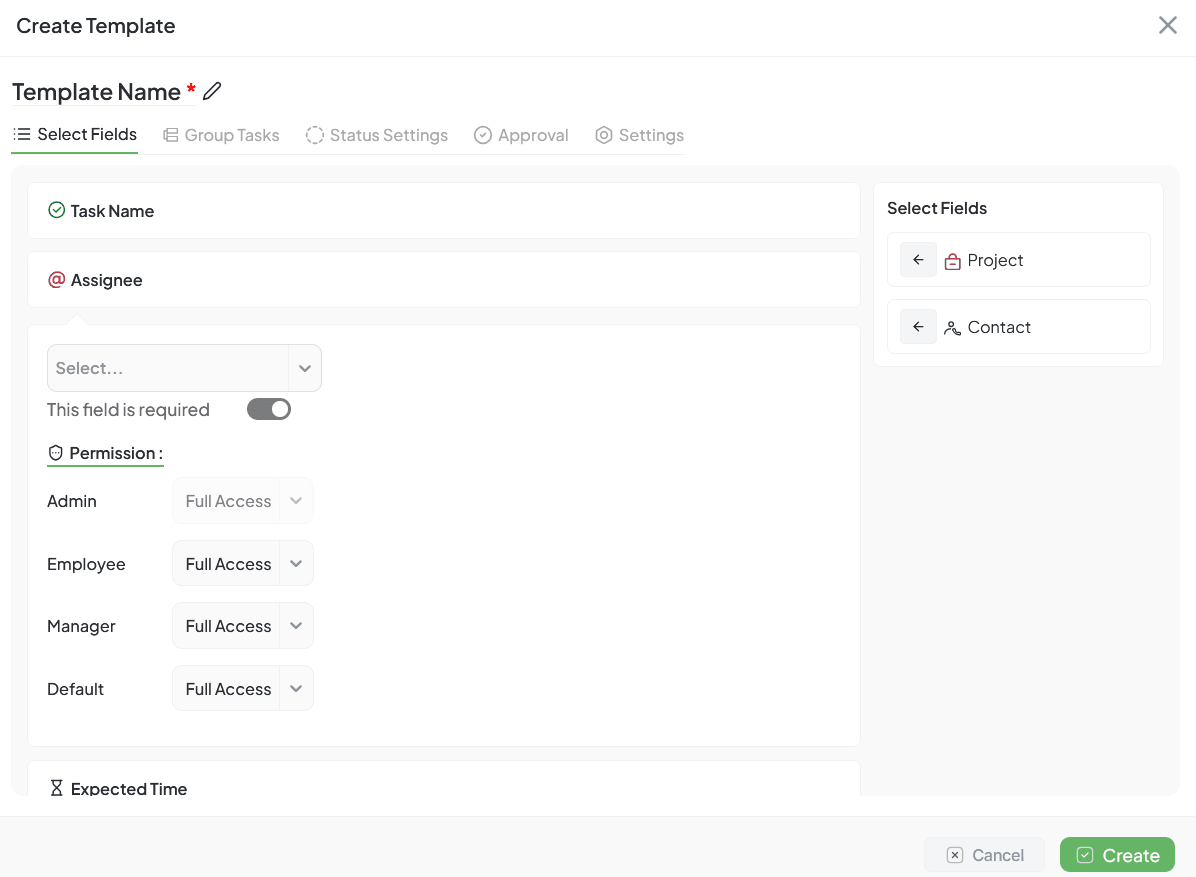
Available Fields
| Field Name | Description |
|---|---|
| Task Name | Enter a name for the task. You can use year, month, day placeholders. |
| Description | Add a detailed description of the task. |
| Assignee | Select the user responsible for completing the task. |
| Labels | Add tags to categorize the task. |
| Expected Time | Set a duration (required). |
| Start Date | Set the starting date of the task. |
| Due Date | Specify the deadline for the task. |
| Project | Link the task to a project. |
| Priority | Set the task's urgency. |
| Flag | Mark the task for visibility or attention. |
Group Tasks Tab
Task Dependencies & Grouping
The Group Tasks tab allows users to add and configure tasks that are dependent on or associated with the main task created via the template. This is useful for workflows involving task dependencies, checklists, or task grouping.
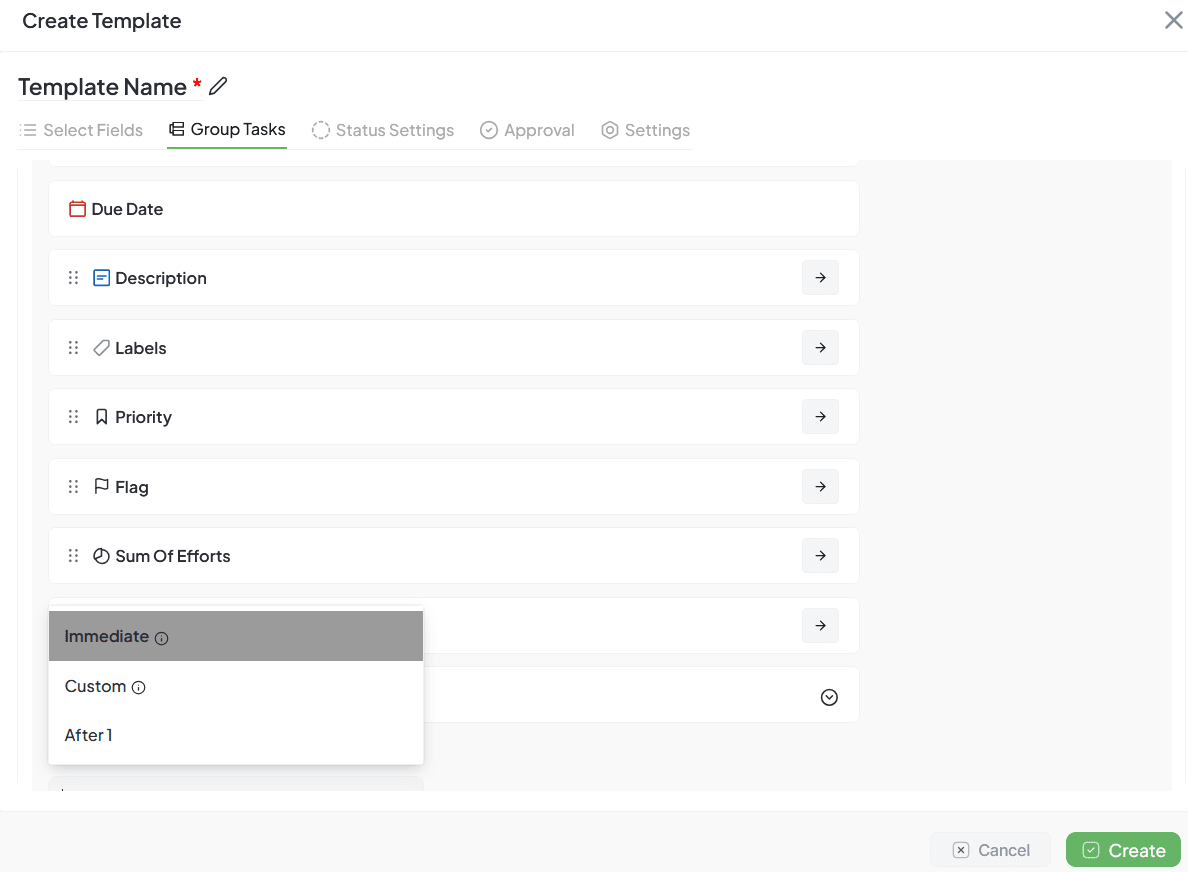
How to Add Group Tasks with Different Status Methods?
1. Accessing the Group Task Section in Templates
- Step 1: Navigate to the Template section in the admin panel.
- Step 2: Click on the Group Tasks tab within the template editor.
- Step 3: If you are creating or updating an existing template, select Add Group Task to create a new group task.
2. Configuring Group Tasks in Templates
In the Group Tasks section, you will be able to define the group tasks with varying start modes and status transitions.
Group Task Fields
| Field | Description | Mandatory |
|---|---|---|
| Task Name | Name of the group task (e.g., Client Communication) | Yes |
| Group Tasks Toggle | Turn ON to add the task as part of the group | Yes |
| Start Mode | Defines when task starts in relation to others (e.g., Immediate, Preceding, After Main Task, Custom) | Yes |
| Status | Defines the task's status type (e.g., Not Started, In Progress, Pending, Completed) | Yes |
| Subtasks | Break down group task into smaller tasks (optional) | No |
| Dependencies | Set task dependencies (e.g., Preceding Task or After Main Task) | No |
Adding Group Tasks with Status Methods
Group Task Status Types:
Each group task can follow one of the status methods based on the Start Mode. Here are the status types for each group task scenario:
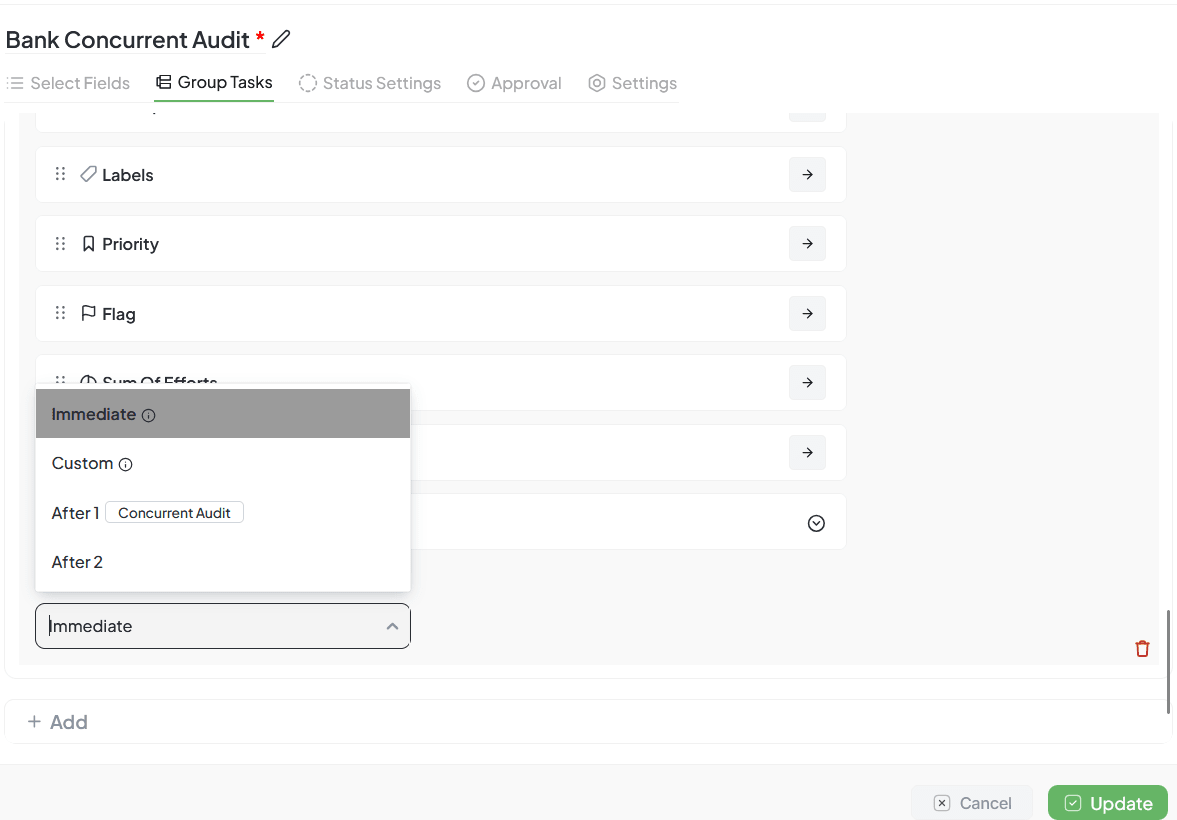
1. Immediate Tasks (Status: In Progress)
Immediate tasks are independent and can start immediately. They have no dependencies and can be marked as In Progress once created.
How to Add Immediate Group Tasks:
- Turn on the Group Tasks toggle.
- Enter the Task Name (e.g., Client Communication).
- Set the Start Mode to Immediate.
- Select In Progress as the initial status.
- Optionally, add subtasks and define the Due Date.
- Click Create.
Status Flow:
Not Started → In Progress → Completed.
2. Preceding Tasks (Status: Waiting)
Preceding tasks depend on the completion of a previous task. They remain in the Waiting state until the preceding task is completed.
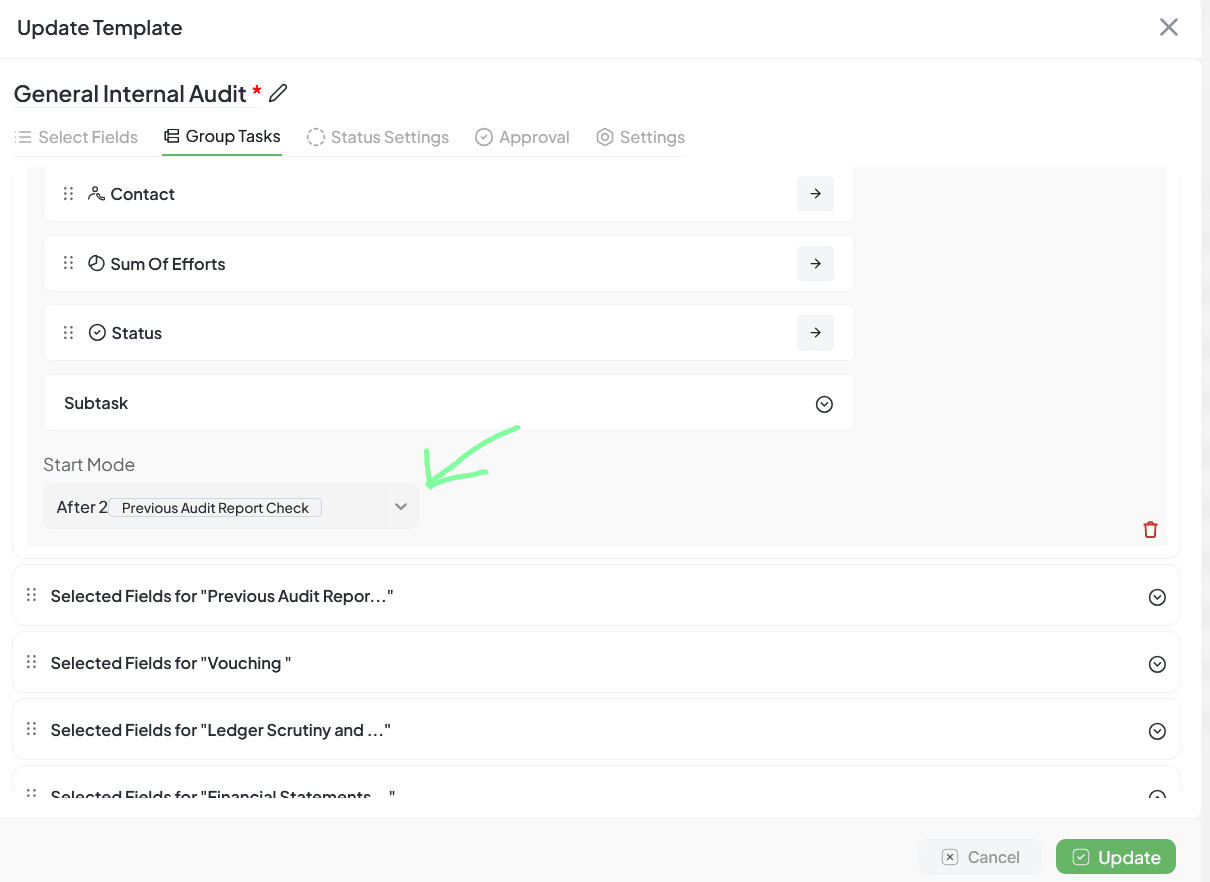
How to Add Preceding Group Tasks:
- Turn on the Group Tasks toggle.
- Enter the Task Name (e.g., Ledger Scrutiny).
- Set the Start Mode to Preceding Tasks.
- Choose the Waiting status to ensure the task remains inactive until the preceding task is completed.
- Optionally, add subtasks and define the Due Date.
- Click Create.
Status Flow:
Waiting (until the preceding task is completed) → In Progress → Completed.
3. After the Main Task (Status: Pending)
After the Main Task refers to tasks that are triggered only once the main task is completed. These tasks have a Pending status until the associated main task is completed.
How to Add Tasks After the Main Task:
- Turn on the Group Tasks toggle.
- Enter the Task Name (e.g., Finalization).
- Set the Start Mode to After Main Task.
- Choose Pending as the status to ensure the task will not begin until the main task is completed.
- Optionally, add subtasks and define the Due Date.
- Click Create.
Status Flow:
Pending (until the main task completes) → In Progress → Completed.
4. Custom Tasks (Status: Custom Waiting Period)
Custom tasks allow you to define the start time relative to other tasks. You can set a custom waiting period for these tasks before they transition to In Progress.
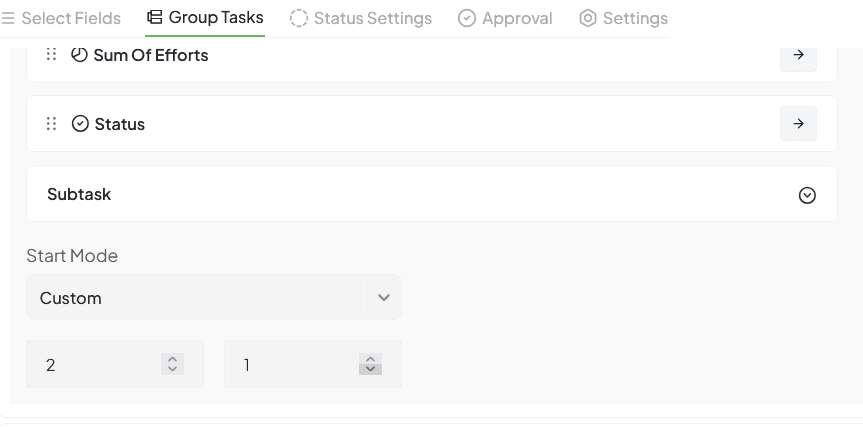
How to Add Custom Group Tasks:
- Turn on the Group Tasks toggle.
- Enter the Task Name (e.g., Update Daily Tracker).
- Set the Start Mode to Custom.
- Specify the Start Date (e.g., After 2 Days from Task Creation).
- Set the Custom Waiting Period status based on the timing configured. You can set a time delay before the task transitions to In Progress.
- Optionally, add subtasks and define the Due Date.
- Click Create.
Status Flow:
Custom Waiting Period → In Progress → Completed.
Task Dependencies and Configuration
Task dependencies ensure that tasks are executed in a specific order. You can configure tasks to depend on one another, with custom triggers for when a task should start. Below are the options available for task dependencies:
- Preceding Tasks: The task can only begin once the previous task is completed.
- After Main Task: The task starts after the main task finishes.
- Custom Delay: Custom configuration allows you to start the task after a delay, for example, starting 2 days after the main task is completed.
Subtask Settings
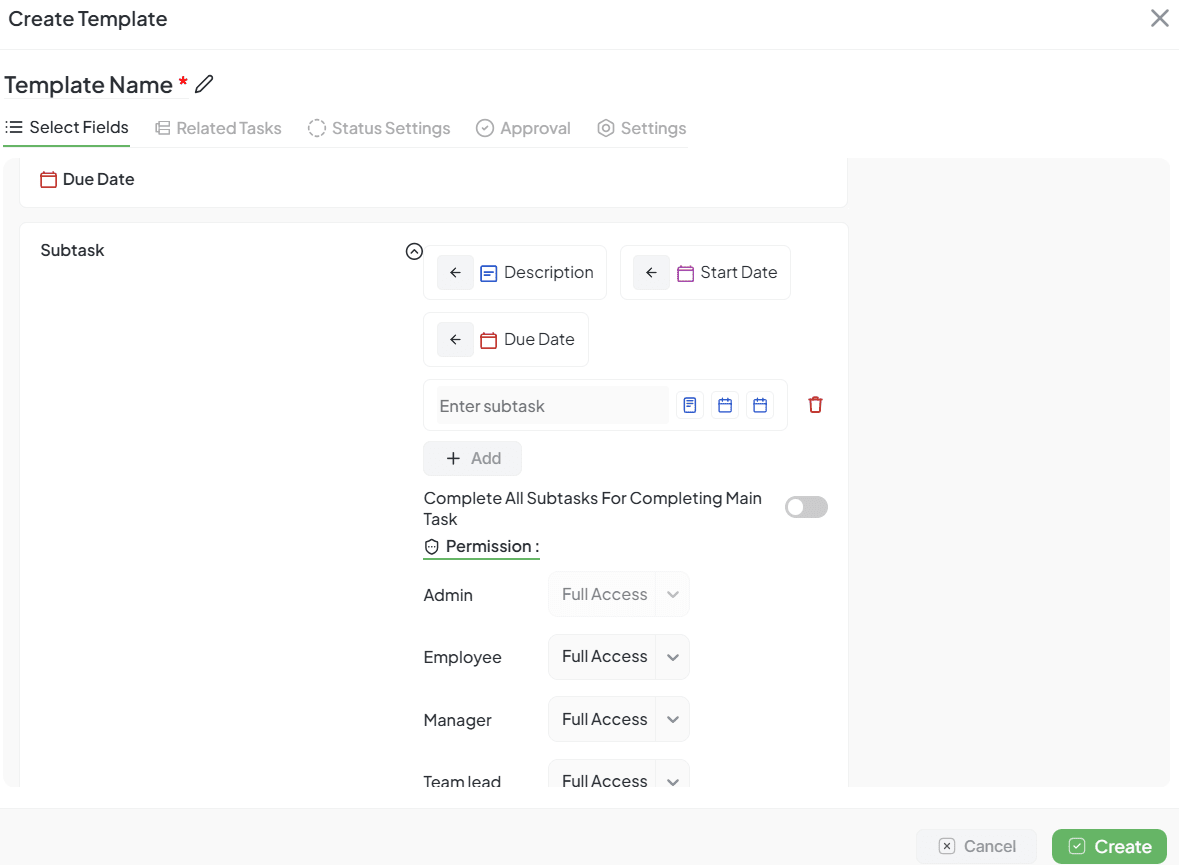
Fields:
- Description
- Start Date
- Due Date
Add button to insert new subtasks.
Delete icon to remove a subtask.
Complete all subtasks for completing the main task.
Permission Settings
Role-Based Permissions:
- Admin: Full Access
- Employee: Add Only / View Only / Full Access
- Manager: Add Only / View Only / Full Access
- Designer: Add Only / View Only / Full Access
Status Settings Tab
Status Configuration
Allows you to assign a set of statuses for tasks created with this template, including default status groups and custom status creation.
.webp)
Status settings interface showing default and custom status options
Default Status Groups
Custom Status Button
The marked button (top-right) redirects to Task Settings for adding custom statuses
⚠ Warning
Always save template before navigating to avoid data loss
Role-Based Permissions
| Role | Access Options |
|---|---|
| Admin | Restricted / Full Access |
| Self | Restricted / Full Access |
| Reporting User | Restricted / Full Access |
Settings Tab
Template Configuration
Configure visibility, tracking, and verification settings for tasks created from this template.
.webp)
Settings tab interface showing configuration options
Settings Options
| Option | Description |
|---|---|
| Time Tracking | Enables time tracking for the task |
| Exclude from Primary List | Hides tasks from the main task list |
| Show in Sidebar | Adds the template to the sidebar |
| Verification Required | Adds an approval step for task creation |
| Additional Verifying Users | Add extra users for task verification |
| Template Visibility - Users | Set which users can view this template |
| Template Visibility - Team | Set which teams can view this template |
| Task Visibility Users | Set visibility permissions for created tasks |
Approval Tab
Approval System
The Approval System in templates ensures that certain tasks or processes go through a verification and approval workflow before progressing to the next status. This feature adds an extra layer of control, quality check, and authorization.
Purpose
Authorization Control
Ensures only authorized users can move tasks forward
Quality Assurance
Adds verification stages to maintain quality and compliance
Review Process
Useful for tasks requiring manager, lead, or client review
Key Features
Verification Required Toggle
OFF: No approval needed | ON: Approval mandatory
Multi-Stage Approval
Support for multiple approval stages in workflow
Stage Configuration
Define approvers, actions, and verification options per stage
.webp)
Add stage approval interface showing stage configuration
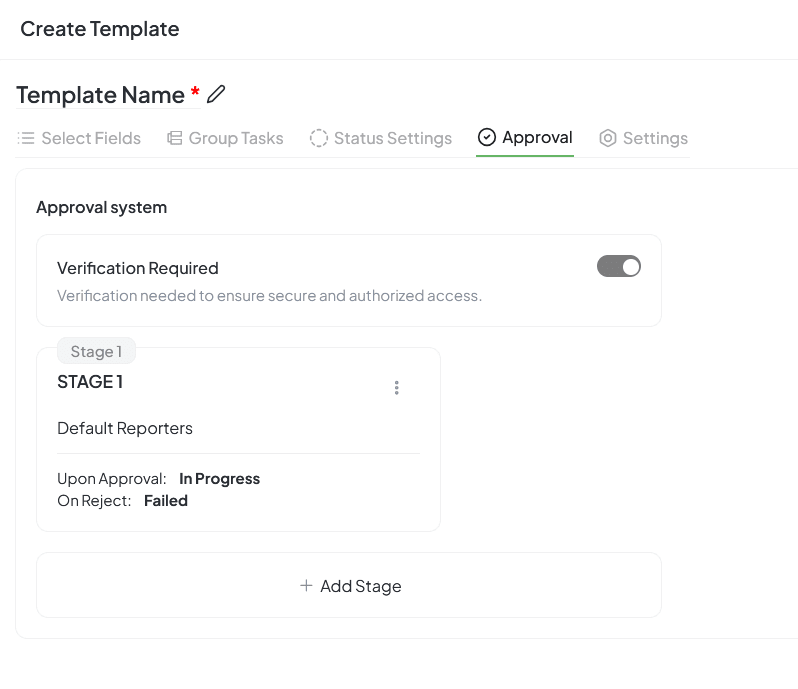
Approval list interface showing multi-stage workflow
Stage Fields
Example Workflow
Marketing Campaign Approval
Benefits
Consistency
Maintain standardized task structures across projects
Efficiency
Automate workflow processes and reduce setup time
Control
Maintain approval workflows and permission controls
Scalability
Easily replicate successful workflows across teams